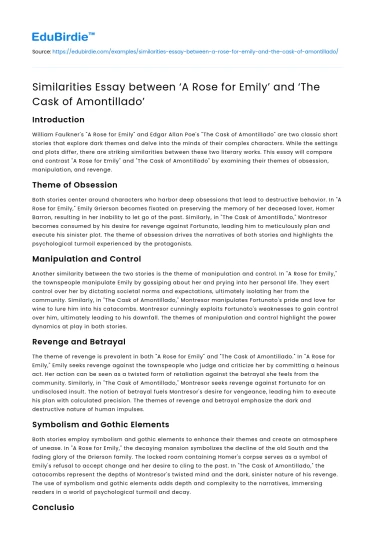Introduction
William Faulkner's "A Rose for Emily" and Edgar Allan Poe's "The Cask of Amontillado" are two classic short stories that explore dark themes and delve into the minds of their complex characters. While the settings and plots differ, there are striking similarities between these two literary works. This essay will compare and contrast "A Rose for Emily" and "The Cask of Amontillado" by examining their themes of obsession, manipulation, and revenge.
Theme of Obsession
Both stories center around characters who harbor deep obsessions that lead to destructive behavior. In "A Rose for Emily," Emily Grierson becomes fixated on preserving the memory of her deceased lover, Homer Barron, resulting in her inability to let go of the past. Similarly, in "The Cask of Amontillado," Montresor becomes consumed by his desire for revenge against Fortunato, leading him to meticulously plan and execute his sinister plot. The theme of obsession drives the narratives of both stories and highlights the psychological turmoil experienced by the protagonists.
Save your time!
We can take care of your essay
- Proper editing and formatting
- Free revision, title page, and bibliography
- Flexible prices and money-back guarantee
Manipulation and Control
Another similarity between the two stories is the theme of manipulation and control. In "A Rose for Emily," the townspeople manipulate Emily by gossiping about her and prying into her personal life. They exert control over her by dictating societal norms and expectations, ultimately isolating her from the community. Similarly, in "The Cask of Amontillado," Montresor manipulates Fortunato's pride and love for wine to lure him into his catacombs. Montresor cunningly exploits Fortunato's weaknesses to gain control over him, ultimately leading to his downfall. The themes of manipulation and control highlight the power dynamics at play in both stories.
Revenge and Betrayal
The theme of revenge is prevalent in both "A Rose for Emily" and "The Cask of Amontillado." In "A Rose for Emily," Emily seeks revenge against the townspeople who judge and criticize her by committing a heinous act. Her action can be seen as a twisted form of retaliation against the betrayal she feels from the community. Similarly, in "The Cask of Amontillado," Montresor seeks revenge against Fortunato for an undisclosed insult. The notion of betrayal fuels Montresor's desire for vengeance, leading him to execute his plan with calculated precision. The themes of revenge and betrayal emphasize the dark and destructive nature of human impulses.
Symbolism and Gothic Elements
Both stories employ symbolism and gothic elements to enhance their themes and create an atmosphere of unease. In "A Rose for Emily," the decaying mansion symbolizes the decline of the old South and the fading glory of the Grierson family. The locked room containing Homer's corpse serves as a symbol of Emily's refusal to accept change and her desire to cling to the past. In "The Cask of Amontillado," the catacombs represent the depths of Montresor's twisted mind and the dark, sinister nature of his revenge. The use of symbolism and gothic elements adds depth and complexity to the narratives, immersing readers in a world of psychological turmoil and decay.
Conclusion
Despite their different settings and plots, "A Rose for Emily" and "The Cask of Amontillado" share several striking similarities. Both stories explore themes of obsession, manipulation, and revenge, delving into the dark and complex depths of human nature. Through their vivid characters, symbolism, and gothic elements, Faulkner and Poe create unsettling narratives that leave readers questioning the boundaries of morality and the consequences of unchecked desires. These timeless works serve as reminders of the profound impact of obsession and the destructive power of revenge.






 Stuck on your essay?
Stuck on your essay?

